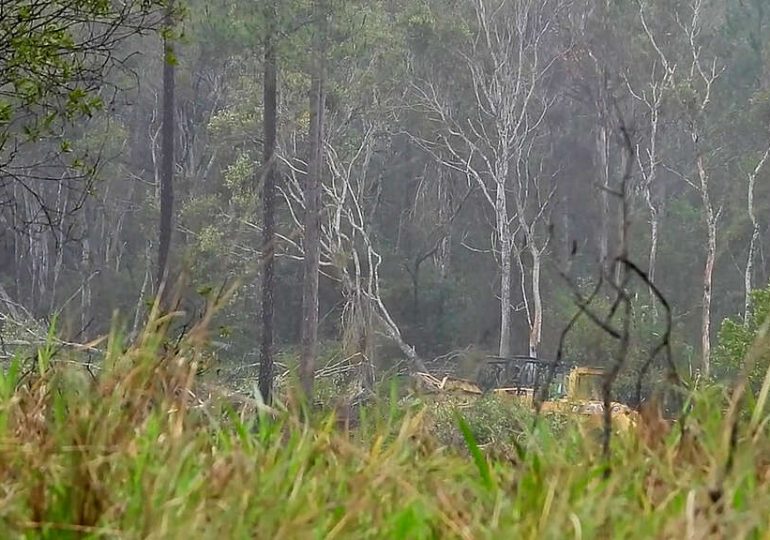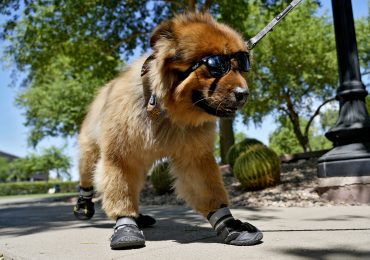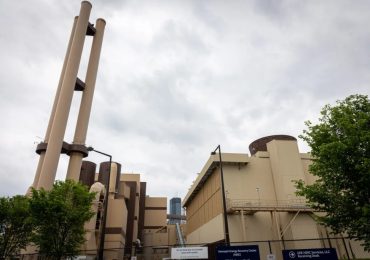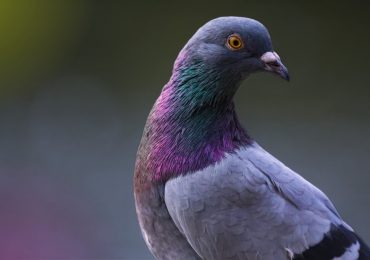Australia has become a global deforestation hotspot but, together, we can turn things around.
Australia is a global winner loser
A hidden deforestation crisis is underway in Australia and our iconic wildlife is under threat. Australia is number one in the world for mammal extinction and number two in the world for biodiversity loss.
Queensland takes the trophy for the state with the highest rates of deforestation – bulldozing more than all the other states and territories combined1. But how did it get so bad?
A bulldozer brutally rips down trees in an Australian forest.
Joh Bjelke-Petersen, Queensland’s longest serving Premier, famously developed a technique for bulldozing massive areas of forest and bushland, using a giant anchor chain connected between two dozers to rip the forest apart. Joh oversaw the destruction of millions of hectares of forest and woodland in the Brigalow Belt of Queensland, which is one of the country’s 15 national biodiversity hotspots2.
Throughout the nineties, the Australian environment movement fought for stronger laws to end the destruction of forests and woodlands. Deforestation rates started to decline before state Governments were urged by industry to loosen laws, and once again rates of deforestation began to climb.
Today, much of the environmental destruction is going on unchecked by government or environmental bodies, so the scale of the problem is hidden from view and only exposed by expert research and investigation.
Satellite images expose deforestation that is hidden from the public view.
What’s the beef with deforestation?
Over 73% of deforestation is for the primary purpose of beef production3. Trees are bulldozed and then piled up and burnt or left to rot, invasive grasses are planted and cattle are brought in.
It’s really no wonder considering Australia is the 4th largest exporter of beef in the world. The majority of beef (60-70%) produced in Australia is for export. The remainder, however, ends up in steaks on the shelves of supermarkets like Woolworths and Coles and patties for burgers sold at fast food restaurants like McDonalds and Hungry Jacks.
Most beef is produced in the state of Queensland, so let’s take a closer look at beef driven deforestation in that state. In the five years from 2016-2021, over 2.2 million hectares of forest and bushland was bulldozed in Queensland alone4. Over 90% of the destruction each year was listed as being for pasture conversion.
While the vast majority of deforestation is for beef pasture, there are many other drivers – logging, mining, urban development and more recently the production of renewable energy.
Australia’s forests and bushland have been chopped, logged, pushed and dozed at scale since colonisation – mainly to create pasture for cattle and livestock. Today, just 50% of Australia’s original forests and bushland remain intact.5
1 second = 1 dead animal
The destruction of forests and bushland is having a huge impact on native animals. Every second a native animal is killed as a result of deforestation6 – in Queensland and New South Wales alone. That is tens of millions of animals and birds killed every year.
Much of the forests being destroyed are home to threatened species. In the 5 years from 2016-2021, 90% of deforestation was in habitat where threatened species are likely to make their homes.
Koalas are now endangered in NSW and QLD due to deforestation
Threatened species like the koala, northern quoll, northern hairy-nosed wombat and many more. Animals are now listed as endangered because they have lost their homes and their lives in a brutal and often bloody way.
Trees are the lungs of the planet – they clean our air and store massive amounts of carbon. When they are bulldozed, that carbon is released. So deforestation not only harms native animals, but it drives the climate crisis as well.
How to win the war on our forests
With all of these dire facts it might be hard to see the how we can save our vulnerable forests, birds and animals. But we have a plan to turn the destruction around – a two-pronged campaign strategy.
Step 1 – Ensure our government makes strong laws
The first step in winning is to make the government step up and bring in strong nature protection laws that don’t let this destruction continue unchecked. This year the Australian government will face a huge test — a once-in-a-generation reform of our national nature laws.
Without strong laws that genuinely protect and restore nature, the destruction of wildlife and forests will continue and countless more native animals will face extinction.
Step 2 – Hold our biggest beef buyers to account
Next we need to get big corporates to clean up their act and, because the leading cause of deforestation is beef production, get it out of their beef supply chains.
We will be exposing the problem and calling on the biggest buyers of Australian beef – supermarkets and fast food chains – to clean up the deforestation in their supply chains.
Ward, M. and Watson, J. 2023. Why Queensland is still ground zero for Australian deforestation. The Conversation. ︎DES. 2018. A Biodiversity Planning Assessment for the Brigalow Belt Bioregion: Expert Panel. Version 2.1. Brisbane: Department of Environment and Science, Queensland Government. ︎The Wilderness Society. 2019. Drivers of Deforestation and land clearing in Queensland. ︎Greenpeace, 2024. New Greenpeace research reveals shocking scale of deforestation crisis in Australia. ︎Corey J. A. Bradshaw, Little left to lose: deforestation and forest degradation in Australia since European colonization, Journal of Plant Ecology, Volume 5, Issue 1, March 2012, Pages 109–120, https://doi.org/10.1093/jpe/rtr038 ︎Finn Hugh C., Stephens Nahiid S. (2017) The invisible harm: land clearing is an issue of animal welfare. Wildlife Research 44, 377-391. ︎
Leave a comment







